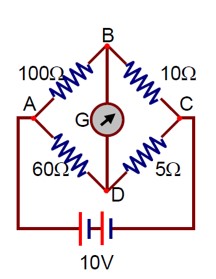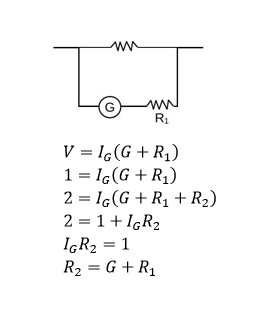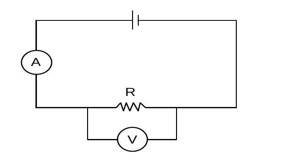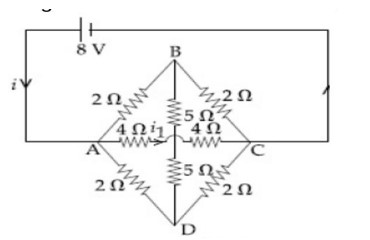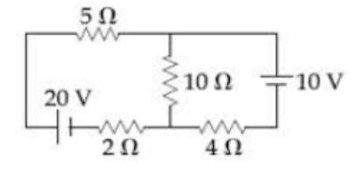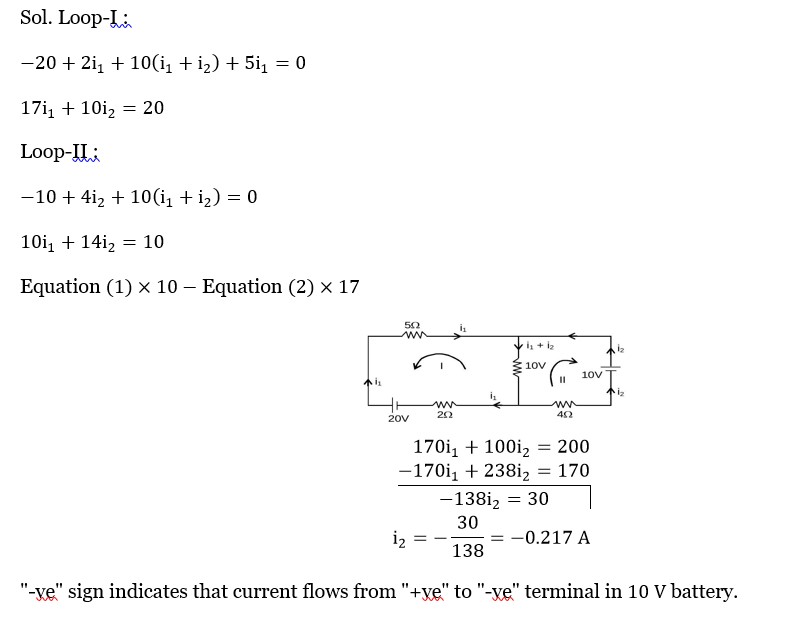Physics Current Electricity
Get insights from 205 questions on Physics Current Electricity, answered by students, alumni, and experts. You may also ask and answer any question you like about Physics Current Electricity
Follow Ask QuestionQuestions
Discussions
Active Users
Followers
New answer posted
a month agoContributor-Level 10
Let V? = 10V, V? = xV, V? = 0V, and V? = yV.
Applying Kirchhoff's current law at node B:
(x - 10)/100 + (x - y)/15 + (x - 0)/10 = 0 ⇒ 53x - 20y = 30 . (1)
Applying Kirchhoff's current law at node D:
(y - 10)/60 + (y - x)/15 + (y - 0)/5 = 0 ⇒ 17y - 4x = 10 . (2)
Solving equations (1) and (2), we get:
x = 0.865 and y = 0.792
The current i? is:
i? = (x - y) / 15 = 4.87 mA
New answer posted
a month agoContributor-Level 9
From ohm's Law, V = IR = I (ρl / A) = I (ρl / (πd²/4) ⇒ ρ = (πd²V) / (4lI)
Relative error in resistivity,
Δρ/ρ = 2 (Δd/d) + ΔV/V + Δl/l + ΔI/I = 2 * (0.01/5.00) + (0.1/5.0) + (0.1/10.0) + (0.01/2000) = 0.039
Percentage error = (Δρ/ρ) * 100 = 3.9%
New answer posted
a month agoContributor-Level 10
For series combination: s = R? + R?
For parallel combination: p = (R? ) / (R? + R? )
Given the condition s = np:
R? + R? = n * (R? ) / (R? + R? )
(R? + R? )² = nR? R?
R? ² + 2R? R? + R? ² = nR? R?
R? ² - 2R? R? + R? ² + 4R? R? = nR? R?
(R? - R? )² = (n - 4)R?
(R? - R? )² / (R? ) = n - 4
n = 4 + (R? - R? )² / (R? )
Since (R? - R? )² is always non-negative, the minimum value of the term (R? - R? )² / (R? ) is 0. This occurs when R? = R?
Therefore, the minimum value of n is 4.
New answer posted
a month agoContributor-Level 10
Given:
- i = 10
- e = 1.6 x 10? ¹? C
- A = 5 x 10?
- V = 2 x 10? ³
The formula for current is I = neAV.
Rearranging for n (number of free electrons per unit volume):
n = I / (eAV)
n = 10 / (1.6 * 10? ¹? * 5 * 10? * 2 * 10? ³)
n = 625 * 10²?
New answer posted
a month agoContributor-Level 10
i? = 40/100 = 2/5
i? = 40/200 = 1/5
V? – V? = 40i? = 40 * 2/5
V? – V? = 16
V? – Vd = 90i? = 90/5 = 18
V? – Vd = 18 – 16 = 2 volt
New answer posted
a month agoContributor-Level 10
In Ohm's law experiment, ammeter is used in series because in series same current will flow through it. But voltmeter is used in parallel to resistor to measure the potential difference across it.
New answer posted
a month agoContributor-Level 10
↑? (1) ε = 3
(2) ε – Ir = 2.5 V
⇒ Ir = 0.5
Now, IR = 2.5
⇒ R/r = 5.
⇒ PR/Pr = I²R/I²r = R/r = 5
⇒ Pr = 0.5/5 = 0.1
Taking an Exam? Selecting a College?
Get authentic answers from experts, students and alumni that you won't find anywhere else
Sign Up on ShikshaOn Shiksha, get access to
- 65k Colleges
- 1.2k Exams
- 687k Reviews
- 1800k Answers

